 |
 |
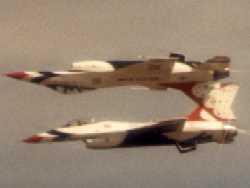
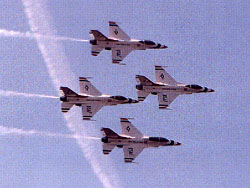 Well, okay, I said some things about the Thunderbirds that may have been a little disparaging, but don't get me wrong. I am always happy to see them. The Thunderbirds perform a fantastic show in the F-16 Fighting Falcon. Their performance is a show of skill and discipline, with excitement and thrills to boot. I have watched them since I was a baby, as my father was a bomber pilot in SAC, and they came to the bases that we lived at with a regular occurence. I got to see them in the F-100's as a little kid, and only missed seeing them perform in the T-38, which I truly regret. I will again give a brief history for those who want to know:
Well, okay, I said some things about the Thunderbirds that may have been a little disparaging, but don't get me wrong. I am always happy to see them. The Thunderbirds perform a fantastic show in the F-16 Fighting Falcon. Their performance is a show of skill and discipline, with excitement and thrills to boot. I have watched them since I was a baby, as my father was a bomber pilot in SAC, and they came to the bases that we lived at with a regular occurence. I got to see them in the F-100's as a little kid, and only missed seeing them perform in the T-38, which I truly regret. I will again give a brief history for those who want to know: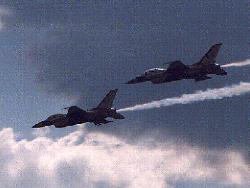
 performed in the F-105 Thunderchief, (another Republic built fighter), that lasted for only six shows! I distinctly remember seeing them in this aircraft and was duly impressed, but the aircraft required a major modification which prompted the return to the F-100. The new Super Sabres were equipped with refueling probes which allowed the team more versatility in where they performed. From 1969 to 1973, the team transitioned and performed in the F-4E, (this being the frontline fighter of the time for the Air Force), which at the same time was made the Navy's aircraft for the Blue Angels, (albeit the Navy version). With the downsizing of the Military in 1974, so were the Airshow aircraft, the Air Force to the T-38 Talon and the Navy to the A-4. The aircraft was a good performer, but was eventually replaced by the F-16A Fighting Falcon in 1983. In 1987, the Thunderbirds were the first U.S. demonstration squadron to perform in a Communist country, that being China. In 1992 the team transitioned to the latest version of the F-16, the "C" model which is still in use today.
I look forward to the next time I see them. I just saw them a couple of weeks ago over the skies of Fairchild AFB, here in Eastern Washington. They looked great. Don't miss them if you get the chance to see them. I don't.
performed in the F-105 Thunderchief, (another Republic built fighter), that lasted for only six shows! I distinctly remember seeing them in this aircraft and was duly impressed, but the aircraft required a major modification which prompted the return to the F-100. The new Super Sabres were equipped with refueling probes which allowed the team more versatility in where they performed. From 1969 to 1973, the team transitioned and performed in the F-4E, (this being the frontline fighter of the time for the Air Force), which at the same time was made the Navy's aircraft for the Blue Angels, (albeit the Navy version). With the downsizing of the Military in 1974, so were the Airshow aircraft, the Air Force to the T-38 Talon and the Navy to the A-4. The aircraft was a good performer, but was eventually replaced by the F-16A Fighting Falcon in 1983. In 1987, the Thunderbirds were the first U.S. demonstration squadron to perform in a Communist country, that being China. In 1992 the team transitioned to the latest version of the F-16, the "C" model which is still in use today.
I look forward to the next time I see them. I just saw them a couple of weeks ago over the skies of Fairchild AFB, here in Eastern Washington. They looked great. Don't miss them if you get the chance to see them. I don't. The Snowbirds
The Snowbirds

 Here is a Team that has been a favorite of the Reno Air Races spectator for years. The Snowbirds hail from Moose Jaw, Saskatchewan, Canada. 431 (AD) Squadron has quite a colorful history which I will attempt to condense with the highlights. The Snowbirds are one of my favorite flight demonstration teams because of the grace with which they perform as a group, and the great show that they fly with 9, (count 'em NINE!) aircraft! They definitely keep the show moving with all of those aircraft zooming around all over the place. I once heard the comment, "There's so many of them! They're everywhere!" That just about sums it up in a nutshell. A brief history of the squadron follows:
Here is a Team that has been a favorite of the Reno Air Races spectator for years. The Snowbirds hail from Moose Jaw, Saskatchewan, Canada. 431 (AD) Squadron has quite a colorful history which I will attempt to condense with the highlights. The Snowbirds are one of my favorite flight demonstration teams because of the grace with which they perform as a group, and the great show that they fly with 9, (count 'em NINE!) aircraft! They definitely keep the show moving with all of those aircraft zooming around all over the place. I once heard the comment, "There's so many of them! They're everywhere!" That just about sums it up in a nutshell. A brief history of the squadron follows: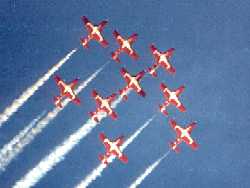
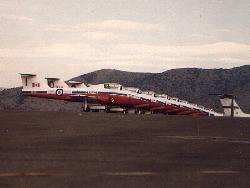 in England for the remainder of the war. 431 was disbanded after their return to Canada in September 1945. 1954 brought the formation of 431 Fighter Squadron to display the F-86 to the public at Airshows, and was disbanded later that same year! Oh, the humanity!? Although the Snowbirds operated on a year to year basis starting in 1971, the Squadron was officially established as a permanent unit in 1978 as the 431 Air Demonstration, (AD), Squadron, flying the CT-114 Tutor. The Team has, in the 30 years of their existence, performed at hundreds of Airshow events in North America and for millions of people. The list of aircraft flown by 431 Squadron since their inception includes many that are recognizable to most aviation history buffs. The Wellington, Halifax and Lancaster represent the bombers, and the F-86 Sabre, CT-33 Silver Star, and currently, the CT-114 Tutor.
in England for the remainder of the war. 431 was disbanded after their return to Canada in September 1945. 1954 brought the formation of 431 Fighter Squadron to display the F-86 to the public at Airshows, and was disbanded later that same year! Oh, the humanity!? Although the Snowbirds operated on a year to year basis starting in 1971, the Squadron was officially established as a permanent unit in 1978 as the 431 Air Demonstration, (AD), Squadron, flying the CT-114 Tutor. The Team has, in the 30 years of their existence, performed at hundreds of Airshow events in North America and for millions of people. The list of aircraft flown by 431 Squadron since their inception includes many that are recognizable to most aviation history buffs. The Wellington, Halifax and Lancaster represent the bombers, and the F-86 Sabre, CT-33 Silver Star, and currently, the CT-114 Tutor.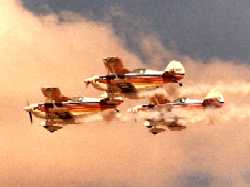
 The Eagles are a team that has been missing from the Airshow circuit and Reno since 1995, when the longest performing Civilian aerobatic team in history, retired. Originally named the Red Devils, the Eagles were made up of three very talented, (that's an understatement, all three were former U.S. National Aerobatic Champions!), pilots. Charlie Hillard, Gene Soucy, and Tom Poberezny developed a precision, high energy, and exciting program using Christen Eagle I aircraft, and in 1972, represented the United States at the World Aerobatic Championships in France.
They came away as Team World Champions! After the Team retired, Charlie was lost in an aircraft accident in 1986. Tom Poberezny has held several executive positions in the EAA, an organization that exemplifies the spirit of the Eagles and has become the leading
The Eagles are a team that has been missing from the Airshow circuit and Reno since 1995, when the longest performing Civilian aerobatic team in history, retired. Originally named the Red Devils, the Eagles were made up of three very talented, (that's an understatement, all three were former U.S. National Aerobatic Champions!), pilots. Charlie Hillard, Gene Soucy, and Tom Poberezny developed a precision, high energy, and exciting program using Christen Eagle I aircraft, and in 1972, represented the United States at the World Aerobatic Championships in France.
They came away as Team World Champions! After the Team retired, Charlie was lost in an aircraft accident in 1986. Tom Poberezny has held several executive positions in the EAA, an organization that exemplifies the spirit of the Eagles and has become the leading 
 organization in the development of homebuilt aircraft, and aircraft in the experimental category. Gene Soucy, a winner of many individual aerobatic titles and aviation awards, remained on the Airshow circuit and contines to this day, flying performances in an Extra 300 and a highly modified Grumman Ag Cat, that he calls the Showcat. Gene developed the Showcat to perform aerobatic routines which, as of 1999, includes a wing-walking act. He performs for various charities, and in his (SPARE?) time, is a Captain for a major airline. In conclusion, the Eagles were a very important part of the Airshow part of the Reno National Championship Air Races, and I, (along with millions of spectators around the world), enjoyed their program alot. They set the standard for civilian aerobatic teams, and we are all much richer for their work. My thanks to the Eagles for making my Airshow experience that much more complete. I won't forget the team or the many performances I witnessed over the years.
organization in the development of homebuilt aircraft, and aircraft in the experimental category. Gene Soucy, a winner of many individual aerobatic titles and aviation awards, remained on the Airshow circuit and contines to this day, flying performances in an Extra 300 and a highly modified Grumman Ag Cat, that he calls the Showcat. Gene developed the Showcat to perform aerobatic routines which, as of 1999, includes a wing-walking act. He performs for various charities, and in his (SPARE?) time, is a Captain for a major airline. In conclusion, the Eagles were a very important part of the Airshow part of the Reno National Championship Air Races, and I, (along with millions of spectators around the world), enjoyed their program alot. They set the standard for civilian aerobatic teams, and we are all much richer for their work. My thanks to the Eagles for making my Airshow experience that much more complete. I won't forget the team or the many performances I witnessed over the years.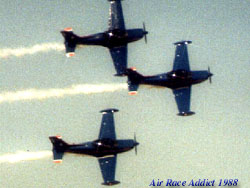
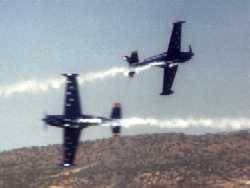 A civilian aerobatic team that had made several appearances at the National Championship Air Races in Reno, Team America was put together to perform at Airshows around the country with a patriotic theme and a wonderful program for the spectator. The team was originally made up of four gentlemen, Chuck Lischer, (Lead Pilot), Barney Register, (Left Wing), and alternating at Right Wing were Frank Sanders and his son Brian. Combined with the skill of these very capable pilots, and the performance of the Marchetti F-260's, Team America performed maneuvers that resembled those of the Military Teams. The F-260 is a high performance aircraft that fit perfectly with the Team's routine. Their act consisted of high speed opposing maneuvers and close formation flying with the incredible Sanders smoke system, (originally designed by the Sanders for NASA vortex research), marking their every move. Frank Sanders was lost in an accident in the Red Knight, a T-33, in 1989 and Brian picked up where his father left off. He was eventually replaced by a man named Jerry Caddick who was with the team the last time Team America performed at Reno in 1994. A definite force in the Airshow world, the team is missed at Reno.
A civilian aerobatic team that had made several appearances at the National Championship Air Races in Reno, Team America was put together to perform at Airshows around the country with a patriotic theme and a wonderful program for the spectator. The team was originally made up of four gentlemen, Chuck Lischer, (Lead Pilot), Barney Register, (Left Wing), and alternating at Right Wing were Frank Sanders and his son Brian. Combined with the skill of these very capable pilots, and the performance of the Marchetti F-260's, Team America performed maneuvers that resembled those of the Military Teams. The F-260 is a high performance aircraft that fit perfectly with the Team's routine. Their act consisted of high speed opposing maneuvers and close formation flying with the incredible Sanders smoke system, (originally designed by the Sanders for NASA vortex research), marking their every move. Frank Sanders was lost in an accident in the Red Knight, a T-33, in 1989 and Brian picked up where his father left off. He was eventually replaced by a man named Jerry Caddick who was with the team the last time Team America performed at Reno in 1994. A definite force in the Airshow world, the team is missed at Reno.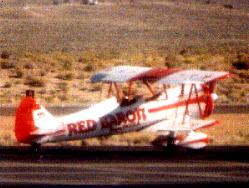
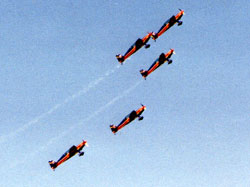 This is the part of the Airshow page where I have to add honorable mentions to some of the Teams who have performed at the Reno Air Races over the last twenty years, some disbanded, others currently performing at other venues around the country. The Red Baron Pizza Squadron and their Stearman Biplanes have appeared at Reno. I have seen them in other cities and they bring back the feeling of the days of barnstorming and daring pilots, the wind whistling around their open cockpits, their white silk scarves trailing in the breeze. They are very entertaining, and I love Red Baron Pizza {;-)
This is the part of the Airshow page where I have to add honorable mentions to some of the Teams who have performed at the Reno Air Races over the last twenty years, some disbanded, others currently performing at other venues around the country. The Red Baron Pizza Squadron and their Stearman Biplanes have appeared at Reno. I have seen them in other cities and they bring back the feeling of the days of barnstorming and daring pilots, the wind whistling around their open cockpits, their white silk scarves trailing in the breeze. They are very entertaining, and I love Red Baron Pizza {;-)
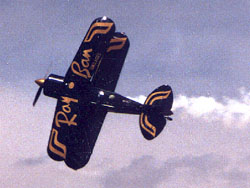 Finally, I would like to mention the Confederate Air Force who have as their mission, to preserve and fly an example of every aircraft from World War Two. I include them in the Teams Page because they, as an organization, are a really important team. They have brought many examples of vintage aircraft to Reno to showcase the organization and the valuable service they perform for the WWII aircraft buff. I also want to mention that they also perform their Tora! Tora! Tora! show at Airshow programs all over North America. If you have ever witnessed the program, you would agree that it is pretty darn spectacular. And, I think that one would agree that a great deal of teamwork is required to bring all of the aircraft, pyrotechnic people, and support personel together to make it happen.
Finally, I would like to mention the Confederate Air Force who have as their mission, to preserve and fly an example of every aircraft from World War Two. I include them in the Teams Page because they, as an organization, are a really important team. They have brought many examples of vintage aircraft to Reno to showcase the organization and the valuable service they perform for the WWII aircraft buff. I also want to mention that they also perform their Tora! Tora! Tora! show at Airshow programs all over North America. If you have ever witnessed the program, you would agree that it is pretty darn spectacular. And, I think that one would agree that a great deal of teamwork is required to bring all of the aircraft, pyrotechnic people, and support personel together to make it happen.| Air Race Addict "Home" |
Airshow "Home" |